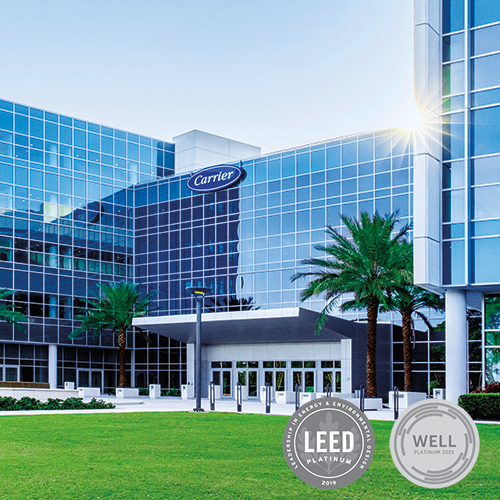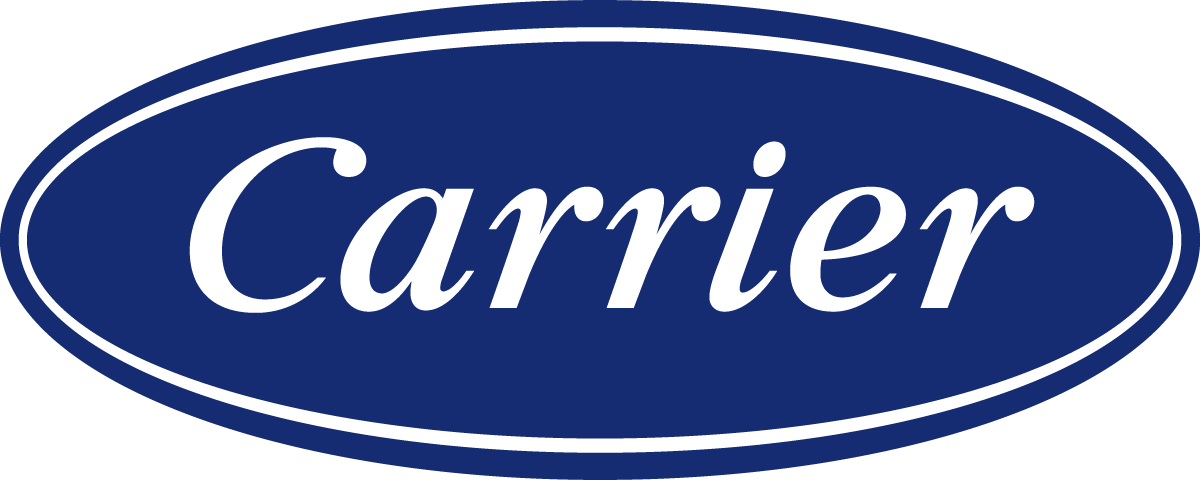

Inspiring confidence in indoor environments
People spend 90% of our time indoors, meaning buildings impact our health, safety, security and performance every day. That’s why Carrier is shaping a healthier future through our Healthy Buildings Program.
Fulfilling our commitment to create solutions that matter for people and our planet, Carrier offers healthy building solutions and services that optimize building systems to enhance the ways occupants live, work, learn and play while indoors. These solutions address foundational elements that contribute to healthy building outcomes, including indoor air quality (IAQ), while helping to enhance sustainability and improve operational efficiency.
Healthy Buildings
With the right strategies and solutions in place, buildings can become powerful tools for human health and productivity.
Discover how Carrier leverages expertise, leadership and innovative solutions to help create healthy indoor environments in buildings around the world.
Ventilation
Thermal Health
Air Quality
Moisture
Filtration - Dust & Pests
Safety & Security
Lighting & Views
Noise
The 9 Foundations of a Healthy Building, Allen, J.D., https://9foundations.forhealth.org
The acceleration of the healthy buildings movement
Healthy buildings awareness can be traced back to the 1980s when indoor ventilation practices led to the first reports of sick building syndrome due to decreased indoor air quality.1 Recently, the healthy buildings movement has formalized and accelerated following the COVID-19 pandemic, increased occupant demand for IAQ education and government policy changes.
For example, the U.S. government announced nearly $200 billion in funding for educational buildings to improve building health through the Elementary and Secondary School Emergency Relief Fund (ESSER) and the Infrastructure Investment and Jobs Act (IIJA), and released the Clean Air in Buildings Challenge to encourage companies to improve building health in other industries.2 Further, a 2020 survey of international real estate investors, with about $6 trillion in assets under management (AUM), reported that 90% planned to enhance their portfolios’ health and wellness strategy.3
Today, the healthy buildings movement is a natural extension of the environmental, social and governance (ESG) movement, and Carrier estimates the market will be worth $10 billion by 2030. The movement is growing because it positively impacts occupants, companies and building owners alike. Healthy buildings can support occupant health by reducing absenteeism and sick days while increasing productivity and cognitive function, which positively impact a company’s bottom line and differentiates them versus competitors.4 Healthy buildings also benefit building owners. MIT’s Real Estate Innovation Lab found healthy-certified buildings pull in effective rents that are 4.4% to 7.7% higher per square foot than non-certified and non-registered peer buildings.5
Together with our global customers and consumers, Carrier is focused on prioritizing building health along with other priorities including sustainability, cost and energy efficiency. Healthy building solutions can benefit all stakeholders when balanced optimally with other considerations.
Occupants4
- Prevention of Disease Transmission
- Increased Productivity and Cognitive Function
Employers4
- Reduced Turnover and Improved Talent Acquisition
- Reduced Labor Costs – Productivity, Healthcare, Absenteeism
Building Owners5,6
- Reduced Vacancies
- Higher Rent Prices
- Reduced Operating Expenses Costs – Emphasis on Preventative Maintenance
- Risk Prevention – Reduced Major Safety Incidents or Shutdowns
1 https://ehp.niehs.nih.gov/doi/pdf/10.1289/ehp.1510037
2https://www.epa.gov/indoor-air-quality-iaq/clean-air-buildings-challenge
3 A New Investor Consensus: The Rising Demand for Healthy Buildings. Health and Real Estate Investment Survey Results. Center for Active Design (CfAD), United Nations Environment Programme Finance Initiative (UNEP FI), and BentallOakGreen (BGO). 2022.
4 https://ehp.niehs.nih.gov/doi/pdf/10.1289/ehp.1510037
5 https://realestateinnovationlab.mit.edu/research_article/the-financial-impact-of-healthy-buildings/
6 https://www.forbes.com/sites/markzettl/2022/03/01/the-green-lease-is-the-next-phase-of-built-environment-sustainability/?sh=52532e205e56
We’re building on a century of commitment to a healthier future.
Creating a world full of healthy buildings takes leadership. And at Carrier, we’ve been providing it for more than a century, starting with our founder. Willis Carrier sold the first modern air conditioning system to Allegheny General Hospital, which was used to establish the first infant incubator room capable of providing a healthy and comfortable environment.
Today, Carrier’s commitment to healthy buildings has evolved beyond healthy products, services and solutions. Partnerships. Sponsorships. Research, investment and our very own showcase facility. We’ve been aggressive and proactive in growing the movement. For a healthier future. For everyone.

It’s time to meet the newest champion for indoor environments
Pro quarterback Russell Wilson is partnering with Carrier to share how we can help customers around the world achieve healthy, safe, sustainable and intelligent indoor environments. Explore the partnership.
The K-12 Healthy Schools Coalition
Carrier is leading a coalition of business leaders, nonprofits and associations that developed implementation principles for the U.S. Department of Energy’s new K-12 Energy Efficiency Program established in the Bipartisan Infrastructure Law. As a result of Carrier’s leadership in supporting healthy schools, Carrier joined Vice President Kamala Harris at a local Washington, D.C., school where she announced the Biden-Harris Action Plan for Building Better School Infrastructure to upgrade public schools with modern, clean, energy-efficient facilities and transportation.
Carrier Center for Intelligent Buildings
We designed and built the Carrier Center for Intelligent Buildings, a flagship headquarters facility in Palm Beach Gardens, Florida, to demonstrate what a healthy, safe, sustainable and intelligent building could be for customers and employees. The building is an integrated and interactive experience of Carrier products and solutions and the first commercial building in Florida to earn both WELL and LEED Platinum certifications. In early 2022, it was the first building to earn the Carrier Certified Healthy Air Systems (CCHAS) seal.

The International WELL Building Institute
Carrier is a founding member of the International WELL Building Institute (IWBI), the world's leading organization focused on deploying people-first places to advance a global culture of health. Together, we are advancing industry engagement globally through education and the adoption of healthy building practices. The goal is simple – to enable us all to be indoors, in the places we love, with confidence.

The U.S. Green Building Council
As a founding member of the U.S. Green Building Council (USGBC), Carrier is committed to changing the way buildings are designed, built and operated. Healthy buildings and green initiatives provide communities with healthier spaces.Healthy buildings aren’t just about solutions. They’re about science.
At Carrier, we’ve made it our mission to advance and understand that science better than anyone. Our support for groundbreaking research led by the Harvard T.H. Chan School of Public Health, called the COGfx (cognitive function) Study series.
The COGfx Study series highlights the impact of built environments on occupants, employers and building owners considering health, productivity, operations and finances. In addition, the studies discuss ways buildings can balance health goals along with sustainability and budget goals.

Study 1A: The Impact of Green Buildings on Cognitive Function1
Occupant cognitive test scores were 61% higher in environments with lower concentrations of volatile organic compounds (VOCs) and 101% higher in environments with lower VOCs and increased outdoor air ventilation rates than conventional environments.

Study 1B: Economic, Environmental and Health Implications of Enhanced Ventilation in Office Buildings2
Doubling ventilation rates from the ASHRAE minimum requirements while adding an energy recovery ventilation (ERV) system led to net savings in energy costs, in many test scenarios.
At the highest ventilation rates, the addition of an ERV system neutralized the environmental impact of increased ventilation. The same change in ventilation improved occupant productivity at a value of $6,500 annually per worker.

Study 2: Buildingomics3
Workers in green-certified buildings scored 26% higher on cognitive tests and had 30% fewer sick building symptoms than those in non-certified buildings.

Study 3: Global Buildings4
Higher particulate matter (PM2.5) and carbon dioxide (CO2), an indicator for lower ventilation rates, were associated with slower response times and lower accuracy on two cognitive tests over a year of testing across a global sample of occupants in similar buildings.
“Enhanced filtration and higher ventilation rates that exceed current minimum targets are essential public health strategies.”
1 https://ehp.niehs.nih.gov/doi/pdf/10.1289/ehp.1510037
2 https://www.mdpi.com/1660-4601/12/11/14709/html
3 https://www.sciencedirect.com/science/article/pii/S0360132316304723
4 https://iopscience.iop.org/article/10.1088/1748-9326/ac1bd8
Healthy buildings innovation at Carrier
In the last three years, Carrier has invested over $1.3 billion in research and development across our businesses to fuel growth and meet the changing needs of our customers and planet. Many new innovations and technologies focus on enabling healthier buildings from IAQ assessment tools to digital platforms that can continuously monitor building health in real time. Our solution portfolio is designed to meet the immediate needs of customers and support them long-term across their healthy buildings journey.

Abound
The future of buildings starts here
Data is essential to informing and automating actions to enable healthy, safe indoor environments and achieving healthy building outcomes. That’s why Carrier created Abound – a suite of connected solutions and cloud-based digital platform that uses advanced technologies to enable real-time, intelligent outcome-based results, making buildings more efficient and responsive, and provide occupants with confidence in their indoor environments.
A healthier future starts indoors.
Indoor environments have a major impact on the way people live. It’s why Carrier is setting out to transform those environments to make them healthier than ever before. And we’re working with customers to make it happen.
Initial assessments. Commissioning and certification. Continuous monitoring and ongoing service. We offer a holistic set of services and solutions to meet customers no matter what industry or building type they’re in, or where they are on their healthy buildings journey. Because to us, every building should be a healthy building.
